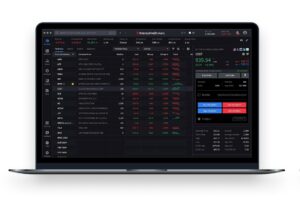The Dow Jones Index (US30) was down 2.48% on Monday. The S&P 500 Index (US500) decreased by 2.36%. The Nasdaq Technology Index (US100) fell 2.46%. The US stocks fell sharply on Monday after President Trump stepped up criticism of Federal Reserve Chairman Jerome Powell, heightening concerns about the Central Bank’s independence and undermining investor confidence. All 11 sectors ended trading in the negative, with technology, consumer discretionary, and energy stocks the hardest hit. In his Truth social media post, Trump called Powell “Mr. Too Late, a major lose” and demanded an immediate rate cut, just days after he said his team might consider removing Powell from his post. Uncertainty over global trade, especially with China, further weighed on sentiment as talks made little progress.
The Canadian dollar strengthened to $1.38 in April, hitting a six-month high, as investors digested the Bank of Canada’s recent decision, coupled with a weaker US dollar. The Bank of Canada kept its benchmark rate unchanged at 2.75%, citing the unclear outlook for tariffs in the US, which could either support solid growth with inflation around 2% or, if tariffs intensify, trigger a recession and higher inflation. In addition, China’s 90% cut in US oil imports has caused more than a quarter of its demand for offshore crude to shift to Canadian barrels.
The Mexican peso strengthened to 19.6 per dollar, a near six-month high, helped by general weakness in the US dollar, exacerbated by relatively high Banxico interest rates. The peso was bolstered by a “very productive” conversation between Presidents Trump and Sheinbaum, which allayed fears of new tariffs on steel, cars, and tomatoes, as well as steady oil export revenues that continue to boost Mexico’s trade receipts.
Equity markets in Europe were not trading on Friday and Monday.
WTI crude prices fell by 2.5% to $63.1 a barrel on Monday as easing tensions between the US and Iran raised the likelihood that more Iranian oil would return to the market. Talks between the two sides have made “very good progress”, and a framework for a potential nuclear deal is planned.
The US natural gas (XNG/USD) prices fell more than 5% to $3.0/MMBtu, the lowest level since late January, as record production and projections for milder weather lowered demand expectations. At the same time, uncertainty over President Trump’s tariff policy change has raised concerns about a slowing global economy and lower energy demand.
Asian markets traded without a single dynamic. Japan’s Nikkei 225 (JP225) was down 1.30%, China’s FTSE China A50 (CHA50) was up 0.06%, Hong Kong’s Hang Seng (HK50) and the ASX 200 (AU200) were not trading on Friday and Monday.
The People’s Bank of China (PBoC) is encouraging state-owned enterprises to use the yuan for payments and settlements in overseas transactions, seeking to expand the currency’s use globally amid ongoing trade tensions. The PBoC said it will strengthen the cross-border interbank payment system (CIPS), promote the implementation of blockchain to ensure the security and efficiency of global settlement services, and support the Shanghai Gold Exchange in cooperation with overseas exchanges to expand the use of yuan reference prices in major global markets.
The Australian dollar climbed above $0.64 on Tuesday, hitting its highest level in four months, as renewed criticism of the Federal Reserve from President Trump undermined investor confidence in US assets. Frustration over stalled global trade talks also weighed on sentiment, as China strongly opposes Trump’s tariff demands. On the domestic front, traders are increasingly betting that the Reserve Bank of Australia (RBA) will cut interest rates at its May meeting. While a 25 basis point rate cut is widely expected, some are pricing in a more aggressive 50 basis point rate cut amid growing fears of a global economic slowdown caused by trade tensions.
Markets still expect the Reserve Bank of New Zealand (RBNZ) to cut its 3.5% monetary rate by 25 bps in May, with a further cut to 2.75% by the end of the year. In terms of economic news, trade data for March showed New Zealand exports up 19% year-on-year, while imports rose 12%. These trends contributed to a double trade surplus of $970 million, the largest since the pandemic in 2020.
This article reflects a personal opinion and should not be interpreted as an investment advice, and/or offer, and/or a persistent request for carrying out financial transactions, and/or a guarantee, and/or a forecast of future events.









